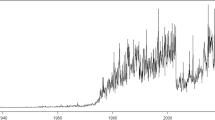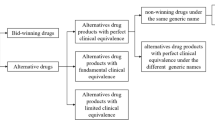Abstract
Background
The number of original and supplemental ANDAs, BLAs, NDAs, and Biosimilars FDA drug/biologic approvals (Approvals) has risen dramatically in the recent years, incidentally, so has the number of issued FDA guidances (Guidances). It is hypothesized that if the structures of the two timeseries are similar and/or concomitantly co-evolving, then there is a relationship between the two variables that may be worthy of further investigation.
Methods
Structural breakpoint (SBP) and cointegration (CI) analyses are used to provide insights into the relatedness of the two timeseries (Approvals, Guidances). Various descriptive statistics (e.g., nonparametric correlation testing, decomposition, unit testing, stationarity, and maximum order of integration) were also performed to better understand the nature of the timeseries understudy.
Results
Structural breaks were identified with the following dates: Approvals (1983, 1989, 1996, 2004, and 2012) and Guidances (1995 and 2012). Approvals and Guidances were (medium) correlative, nonstationary, and cointegrated with a maximum order of integration of one (I(1)). Descriptive statistical markers suggest additional similarities (e.g., seasonal variation) between the two timeseries.
Conclusions
To the author’s knowledge, this is the first work to empirically investigate Guidances and their relationship with Approvals. The similarity in the structure of the timeseries (e.g., seasonal variation, SBPs and CI) suggests a deeper relationship between Guidances and Approvals, including the existence of a “long-run” equilibrium (wherein one or more exogenous factors restrain the divergence) between the two variables. This work offers an exciting opportunity for further research into the processes influencing the rates of Approvals and Guidances. A discussion on the limitations of the approach is also presented.




Similar content being viewed by others
References
Kesselheim AS, Woloshin S, Lu Z, Tessema FA, Ross KM, Schwartz LM. Physicians’ perspectives on FDA approval standards and off-label drug marketing. JAMA Intern Med. 2019;179(5):707–9. https://doi.org/10.1001/jamainternmed.2018.8121.
Morrison C. Fresh from the Biotech Pipeline 2018. Nat Biotech. 2019;37:118–23.
Weintraub W. FDA promises ‘elevated’ new drug approvals but warns of potential pitfalls: report. Fierce Pharmax. https://www.fiercepharma.com/pharma/fda-promises-elevated-new-drug-approvals-but-warns-potential-pitfalls-report (2019). Accessed 10 Jul 2019.
Daizadeh I. Pulmonary arterial hypertension: a case study in FDA expedited program designations. Ther Innov Regul Sci. 2019;53:264–9.
Cai J, Wang T, McAuslane N, Liberti L. OP172 Do expedited regulatory pathways affect time to health technology assessment decision? Int J Technol Assess Health Care. 2019;34(51):63.
Hwang TJ, Franklin JM, Chen CT, Lauffenburger JC, Gyawali B, Kesselheim A, Darrow JJ. Efficacy, safety, and regulatory approval of food and drug administration-designated breakthrough and nonbreakthrough cancer medicines. J Clin Oncol. 2018;36(18):1805–12.
Mostaghim Sana R, Gagne Joshua J, Kesselheim Aaron S. Safety related label changes for new drugs after approval in the US through expedited regulatory pathways: retrospective cohort study. BMJ. 2017;358:j3837.
CFR10.115. https://www.accessdata.fda.gov/scripts/cdrh/cfdocs/cfcfr/CFRSearch.cfm?fr=10.115 (2019).
FDA Guidance. IRB Waiver or alteration of informed consent for clinical investigations involving no more than minimal risk to human subjects (2017).
FDA Guidance. Cancer clinical trial eligibility criteria: minimum age for pediatric patients (2019).
FDA Guidance. SPL Standard for Content of Labeling Technical Qs & As (2009).
Berndt EB, Gottschalk AHB, Philipson TJ, Strobeck MW. Industry funding of the FDA: effects of PDUFA on approval times and withdrawal rates. Nat Rev Drug Discovery. 2005;4:545–54.
Prescription Drug User Fee Act (PDUFA). PDUFA legislation and background (2012).
Kinch MS, Griesenauer RH. 2017 in review: FDA approvals of new molecular entities. Drug Discov Today. 2018;23(8):1469–73.
Zeileis A, Leisch F, Hornik F, Kleiber C. strucchange: an R package for testing for structural change in linear regression models. J Stat Softw. 2002;7(2):1–38.
Bai J, Perron P. Computation and analysis of multiple structural change models. J Appl Econ. 2003;18:1–22.
Zeileis A, Kleiber C, Krämer W, Hornik K. Testing and dating of structural changes in practice. Comput Stat Data Anal. 2003;44:109–23. https://doi.org/10.1016/S0167-9473(03)00030-6.
Messer M, Albert S, Plomer S, Schneider G. MFT: the multiple filter test for change point detection. R package version 2.0. https://CRAN.R-project.org/package=MFT (2019).
Erdman C, Emerson JW. bcp: an R package for performing a bayesian analysis of change point problems. J Stat Softw. 2007;23(3):1–13.
Trapletti A, Hornik K. tseries: Time series analysis and computational finance. R package version 0.10-47 (2019).
Pfaff B. Analysis of integrated and cointegrated time series with R. 2nd ed. New York: Springer; 2008. ISBN 0-387-27960-1.
EvaluatePharma®, as of June 2019.
R Core Team. R: A language and environment for statistical computing. Vienna: R Foundation for Statistical Computing. https://www.R-project.org/. R Version 3.6.1 (2019). Accessed 05 July 2019.
Komsta L, Novomestky F. moments: Moments, cumulants, skewness, kurtosis and related tests. R package version 0.14. https://CRAN.R-project.org/package=moments (2015).
Pfaff Bernhard. VAR, SVAR and SVEC models: implementation within R Package vars. J Stat Softw. 2008;27(4):132.
Zeileis A, Leisch F, Kleiber C, Hornik K. Monitoring structural change in dynamic econometric models. J Appl Econ. 2005;20(1):99–121.
Beall RF, Hwang TJ, Kesselheim AS. Pre-market development times for biologic versus small-molecule drugs. Nat Biotechnol. 2019;37:708–11.
Myers N, Steding CE, Mokolaj P. Competing policy windows in biotechnology: the FDA, 21st Century Cures Act, and laboratory-developed tests. Rev Policy Res. 2017;35(1):89–119.
Gillespie JJ, Privitera GJ, Gaspero J. Biopharmaceutical entrepreneurship, open innovation, and the knowledge economy. J Innov Manag. 2019;7(2):59–77.
Prevezer M. The dynamics of industrial clustering in biotechnology. Small Bus Econ. 1997;9(3):255–71.
Daizadeh I. An intellectual property-based corporate strategy: an R&D spend, patent, trademark, media communication, and market price innovation agenda. Scientometrics. 2009;80(3):731–46.
Sabbagh MN, Hendrix S, Harrison JE. FDA position statement “Early Alzheimer’s disease: developing drugs for treatment, guidance for Industry”. Alzheimer’s Dementia. 2019;5:13–9.
de Vlieger JSB, Crommelin DJA, Tyner K, Drummon DC, Jiang W, McNeil SE, Neervannan S, Criist RM, Shah VP. Report of the AAPS Guidance Forum on the FDA draft guidance for industry: “drug products, including biological products, that contain nanomaterials”. AAPS J. 2019;21:56. https://doi.org/10.1208/s12248-019-0329-7.
Dancey JE, Dobbin KK, Groshen S, Jessup JM, Hruszkewycz AH, Koehler M, Parchment R, Ratain MJ, Shankar LK, Stadler WM, True LD, Gravell A, Grever MR, On behalf of the Biomarkers Task Force of the NCI Investigational Drug Steering Committee. Guidelines for the development and incorporation of biomarker studies in early clinical trials of novel agents. Clin Cancer Res. 2010;16(6):1745–55. https://doi.org/10.1158/1078-0432.CCR-09-2167.
Kleiber C. Structural change in (economic) time series. In: Müller S, Plath P, Radons G, Fuchs A, editors. Complexity and synergetics. Cham: Springer; 2018. p. 275–86.
Wang X, Emerson JW. Bayesian change point analysis of linear models on general graphs, Working Paper (2015).
Erdman C, Emerson JW. A fast Bayesian change point analysis for the segmentation of microarray data. Bioinformatics. 2008;24(19):2143–8.
Toda HY, Yamamoto T. Statistical inference in vector autoregressions with possibly integrated processes. J Econ. 1995;66:225–50. https://doi.org/10.1016/0304-4076(94)01616-8.
Acknowledgements
The author extends gratitude to B. Stretch for provision of the Approvals data, and N.D., S.L.D., and N.L.D. for their support of the manuscript.
Disclosures
The author is an employee of Pfizer, Inc. The views expressed in this article may not necessarily represent those of Pfizer, Inc.
Author information
Authors and Affiliations
Corresponding author
Ethics declarations
Research Involving Human and Animal Rights
This article does not contain any studies with human or animal subjects performed by any of the authors.
Additional information
Publisher's Note
Springer Nature remains neutral with regard to jurisdictional claims in published maps and institutional affiliations.
Electronic supplementary material
Below is the link to the electronic supplementary material.
Rights and permissions
About this article
Cite this article
Daizadeh, I. Investigating Rates of Food and Drug Administration Approvals and Guidances in Drug Development: A Structural Breakpoint/Cointegration Timeseries Analysis. Ther Innov Regul Sci 54, 1056–1067 (2020). https://doi.org/10.1007/s43441-020-00123-5
Received:
Accepted:
Published:
Issue Date:
DOI: https://doi.org/10.1007/s43441-020-00123-5




